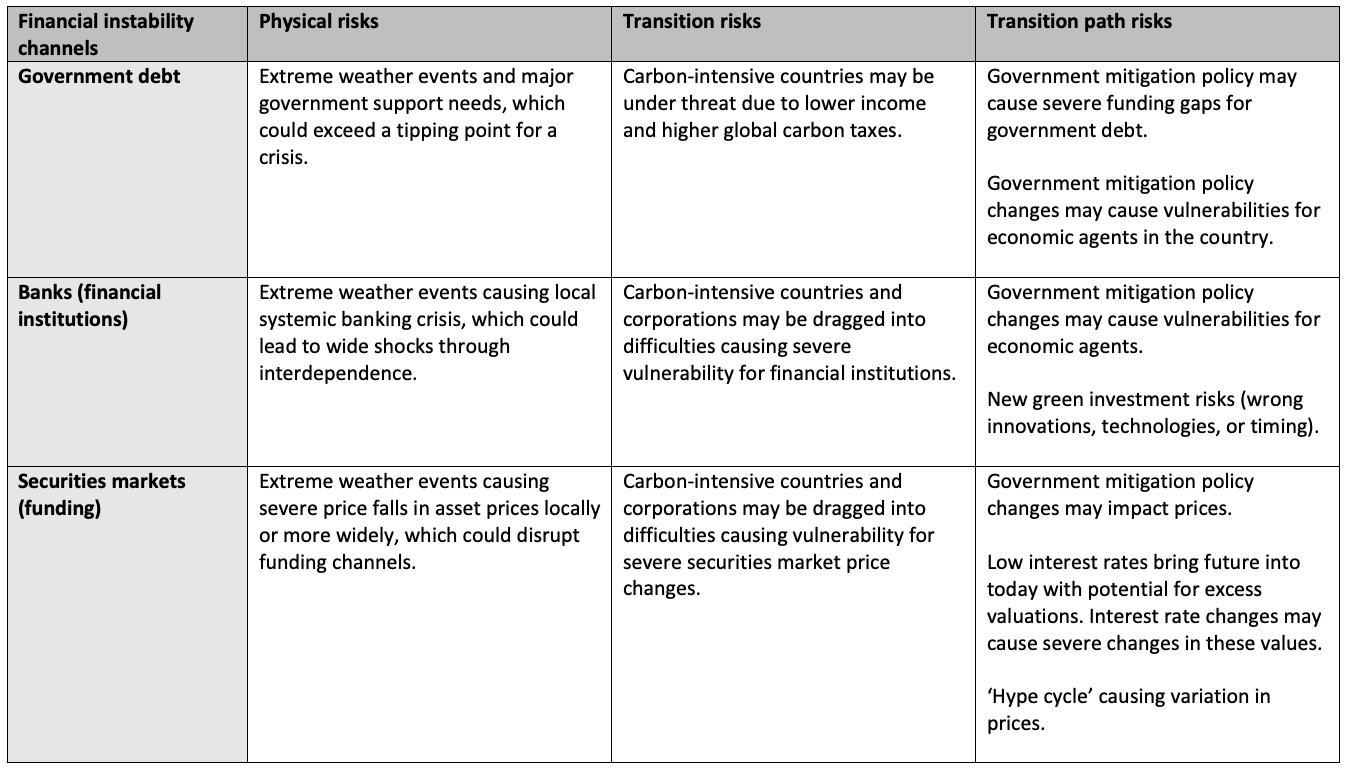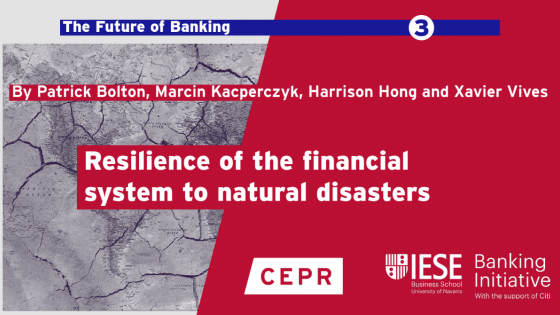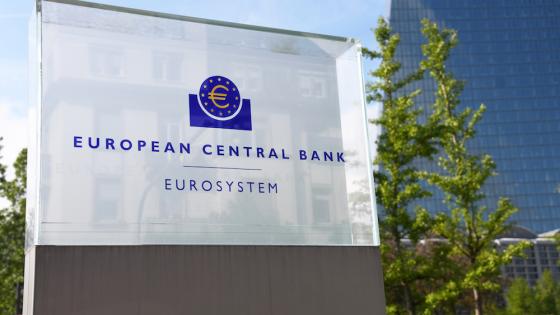The concept of financial stability can be easily seen when there is a state of financial instability. In this column, I try to incorporate climate change into the concept of financial stability. Climate change is not in itself a financial stability matter, but it may cause and trigger financial stability concerns via channels which are commonly understood as most vulnerable. Government debt financing is prone to crises, the banking sector is vulnerable to runs, and securities market price and liquidity fluctuations may cause financial instability.
Financial stability is at the core of central banking. The central banking community has widely incorporated climate change risks as part of central banking discussions. It is widely accepted that climate change could pose such risks that central banks need to evaluate the risks within their current mandates. Mark Carney (2015) has been the leading advocate for incorporating climate change risks in financing decisions. He raised concerns regarding the tragedy on the horizon as business cycles, political cycles, and technocratic authorities may reduce the incentives of the players to fix the problem.
The Network for Greening the Financial System’s (NGFS) initiative, Bolton et al. (2020), FSB (2020), and the 2021 Bank for International Settlements (BIS) Green Swan Conference have recently brought the seriousness of climate change as a financial stability matter to the attention of central banks and market participants.1
Recently, Bolton et al. (2021) suggested that the climate change risk is to be included in the mandates of central banks. However, central banks are not the main engines for change, but they are part of all the financial players taking climate change into their calculations. Governments throughout the globe are the key players in making the necessary policy changes to accommodate the necessary changes for a carbon neutral world.
Gore and Blood (2013) popularised the term ‘stranded assets’ to highlight the economic impact of the transition to a low-carbon economy. Recently, Giglio et al. (2020) reviewed the climate finance literature and pricing of financial assets and real estate assets due to climate change risks.
Distinguishing normal changes and fluctuations in the economy from crises and instability-triggering developments is hard to tell ex-ante. Most negative economic trends and variability will be naturally washed away by market adjustments and balancing acts by economic agents. Some negative trends will be reversed by active government and central bank policies. Extraordinary and non-conventional policies are called upon if normal policies are not sufficient for restoring stability in the economy.
Definition of financial stability
There is no widely accepted definition of financial stability. The concept of stability can be best seen in the presence of instability. However, one could define financial stability in the following manner:
Financial instability is a real or expected danger in financial markets or financial institutions due to an event which, if not reacted upon by public authorities, could potentially cause a severely negative impact on the real economy, non-functioning of the monetary economy (payment system), and/or non-functioning of financial markets (funding).
Acts of financial stability are actions to prevent, resolve or restore financial stability in the presence of real or expected threats of financial instability.
Acts of financial stability include prevention, resolution, and restoration. Prevention includes setting up policies and regulation, but it also includes monitoring and supervision for safeguarding correct action by economic agents. Resolution means orderly acts of financial stability in times of crisis. There may be rules in place to give extra powers to resolution authorities.2 Restoration could be seen as a state in which the crisis has already hit the economy or financial markets, and it has had an impact, but public authorities still need to restore stability by their extraordinary policies or acts.
This definition of financial stability is not changed by the presence of climate change. Climate change is a risk and a potential trigger for causing financial instability via various channels which are vulnerable for causing severe instability.
Challenges in government debt, the banking sector (financial institutions), and abrupt changes in the securities market may cause disruptions for financial stability. This instability may lead to a lower level of trust in currency (money). The use of fiat money is based on it being trusted as a means of exchange, a store of value, and as unit of account. The purpose of financial stability acts by governments and central banks is to enable stable real economic growth and the functioning of the monetary system, but ultimately these acts are to protect the existing fiat money. The further the danger is for financial instability the closer the monetary system and fiat money is under potential mistrust. The mandates of central banks are defined in various ways and wordings.
New climate change transition path risks
Typically, climate change risks are divided into physical and transitional risks. Physical risks are associated with extreme weather, floods, heat, hurricanes, storms, drought, or other similar phenomena stemming from changes in the climate. Transition risks are risks arising from long-term climate change impacts to economic agents directly or indirectly with or without policy changes, and these impacts will be governed by government policy changes and mitigation acts. Economic agents are forced to adjust their behaviours along the way.
In addition to these traditional climate change related risks, there are also other transition path related risks. Transition path risks could arise from investments, mitigation policies, discounted pricing, and the choice of metrics. These come from the expected and chosen transition paths which economic agents are aiming to guess. Each economic agent is estimating the future path. These estimates may turn out to be right or wrong. There is no perfect foresight for the future. Estimates change and the collective synthesis of those estimates will determine the economic impacts.
Transition path risks are the following:
1. Mitigation policy risks
Government policies are imperfect solutions even though the aim is good. Due to wrong policies or practical compromises, governments may not take the right actions which are needed or expected by economic agents, or they may change the policies taken. These abrupt policy changes or misalignments to expectations by economic agents may cause turbulent changes in values. An example is the race to zero carbon economies. The path towards the right goal may take a longer or shorter time and may encompass abrupt changes in policies or policies not aligned with expectations. Regime changes are taking place, but they are hard to predict.
2. Investment risks
New green innovations, technologies, and related investments could include some ‘wrong’ choices. These wrong choices or the timing of these choices could turn out to be bad investments, therefore leading to difficulties for the economic agents and vulnerabilities for the channels and financial instability accelerators.
3. Discounted pricing risks
Present values of current and future green investments are high with a low interest rate environment. This will accelerate the change towards green economies. In these circumstances sensitivities to changes of values and prices are possible and may be intensified with interest rate changes. In addition, the green revolution may create a ‘hype cycle’ witnessed during the ICT-boom at the turn of the century or a ‘green bubble’ advocated in the pre-Paris Agreement era. New technologies could see a cycle of euphoria and reality. Asset price bubbles may emerge.
4. Risk metrics
Reporting on climate change metrics has taken enormous steps during recent years. This development makes it possible to make informed decisions on what is considered good and what is bad. For example, carbon intensity is widely used by investors. There is a risk that the available metrics will be developed further as economic agents collect wisdom. Changes in metrics may cause decisions which could look wrong in hindsight.
These transition path risks could be marginal or significant in comparison to the risks arising from physical and traditional transition risks (Table 1). The future transition path may be bumpy. Climate change as a phenomenon is well supported by scientists and must be taken seriously by all despite possibilities for mistakes along the way.
Table 1 Climate change risks
Transition path risks may cause financial instability via government debt, financial institutions, or securities markets. These transition path risks may cause, in addition to physical risks and transition risks, the financial stability channels and accelerators, such as government debt, banking, and securities market, to be more prone to crises in the coming decades.
For instability to take place the impact needs to be large enough in relation to the prevailing circumstances and the timing needs to be ‘perfect’. Typically risks will materialise if many risks take place at the same time, increasing vulnerabilities manyfold. In Table 2 the key financial instability channels are illustrated as crisis accelerators, integrating those with the physical risks, transition risks, and transition path risks.
Table 2 Climate change risks and financial instability channels
How to mitigate financial stability risks?
Financial stability risks from climate change are mitigated by prevention, resolution, and restoration. Mostly the existing processes for prevention, resolution, and restoration associated with government debt, banking (financial institutions), and securities markets are valid in the context of climate risks. If risks arise slowly, the mechanisms have enough time to be adjusted accordingly. If risks are abrupt, the solutions may be more difficult to get adjusted.
A global crisis may call for global solutions. Local and global crises of various magnitudes and probabilities require sufficient transparency of risks and needed buffers by economic agents. Transparency and disclosure reduce information asymmetries and speed up adjustments and mitigation measures.
Transparency of government policies
Approaches to government support and state aid will need to be agreed globally. This calls for ex-ante transparency of government policies regarding not only grey industries but green industries as well. Carbon taxes should be implemented at the national and international level and at the borders.3
In times of crisis the approaches to resolution for corporations and financial institutions may need to be further aligned across borders. The doom-loop between banks and governments needs to be further reduced to increase the resilience of financial systems to absorb shocks.
Use of multiple metrics
Transparency and exposure analysis are the best tools to detect the risks. Exposures are not only exposures to physical and transition risks but also potential risks from the chosen transition path. Institutions should be using multiple metrics to assess their positions and base their decisions. Reporting and metrics need to be developed further for investors and supervisors to compare companies and make correct assessments.
Security markets as store of value
The securities market is a liquidity and funding provider, in addition to primary market capital raising more so as a store of value and a source for money via security market transactions (liquidity). Sharp market-to-market reactions may be seen as the climate change trend progresses. New financial instruments will be created along the way. Today’s environmental, social, and governance (ESG) and low-carbon products are just the beginning. Markets will find new products and regulators will need to follow and adjust. The most recent example is the crypto currencies which may be using levels of energy which are not aligned with the global climate change trend.
Financial institutions need to be aware of the abovementioned transition path risks which arise from investment risks, mitigation policy risks, discounted pricing risks, and risk metrics. There is a need for further global coordination of various mechanisms and risks which will arise in the coming decades. Restoring financial stability is hopefully not needed if prevention and resolution mechanisms are working properly.
Conclusions
Climate change is a new serious threat to financial stability. Even though the definition of financial stability or channels may not change due to climate change, potential new risks exist in addition to traditional physical and transition risks associated with climate change.
New risks arise from the transition path chosen by the society and the expectation of economic agents. Government policies and regimes may change as more information is gathered and decision makers fine-tune their choices. Economic agents will make mistakes in their innovations and investments. The investment market will price the prospects of financial assets with euphoria and pessimism. Green investment values could potentially be changed abruptly due to changes in technologies and government policies.
These potential risks of climate change may take place even though the transition path towards greener societies is strong. Carbon prices may rise to new highs, as most economists expect. Fossil fuel industries could be in difficulties and some assets could be potentially stranded. The path to get to net zero societies is unclear and no-one has the perfect foresight. Therefore, the financial stability concern arises not only from physical and transition risks, but also from the chosen and constantly changing transition path.
References
Bolton, P, M Despres, L A Pereira Da Silva, F Samama and R Svartzman (2020), ”The green swan: central banking and financial stability in the age of climate change”, Bank for International Settlements and Banque de France, January 2020.
Bolton, P, M Kacperczyk, H Hong and X Vives (2021), Resilience of the Financial System to Natural Disasters, Future of Banking 3, CEPR.
Carney, M (2015), “Breaking the tragedy of the horizon – climate change and financial stability”, Bank of England, 29 September.
Giglio, S, B Kelly and J Stroebel (2020), “Climate finance”, NBER Working Paper Series, December 2020.
Gore, A and D Blood (2013), “The coming carbon asset bubble”, Wall Street Journal, 30 October.
FSB (2011), “Key attributes of effective resolution regimes for financial institutions”, 4 November.
FSB (2020), “The implications of climate change for financial stability”, 23 November.
NGFS (2019), “First Comprehensive Report, a call for action – Climate change as a source of financial risk”, April 2019.
Peszko, G, D van der Mensbrugghe, A Golub, J Ward, D Zenghelis, C Marijs, A Schopp, J A Rogers and A Midgley (2020), “Diversification and cooperation in a decarbonizing world: climate strategies for fossil fuel-dependent countries”, World Bank Group.
Endnotes
1 The Network for Greening the Financial System (NGFS) was created in 2017 and NGFS published its first Comprehensive Report in 2019. The Green Swan 2021 Global Virtual Conference gathered key central banks and financial community to discuss consequences of climate change. The author participated in the panel on financial stability where he made some of the comments presented in this paper.
2 See as an example for banking and financial sector coordinated resolution policies by FSB (2011).
3 Peszko et al. (2020) analysed the impact of various transition paths to fossil fuel dependent countries. They also looked at various diversification strategies and resilience to mitigate the transition to a decarbonising world. They supported the wellhead taxation at the producer level instead of latter stage taxation. This is one example of the global coordination needed to find global solutions for the common goal.





